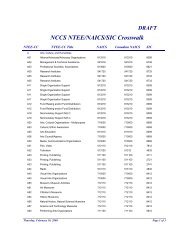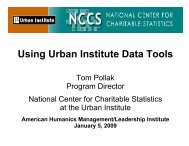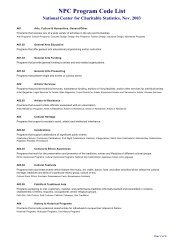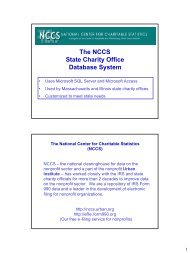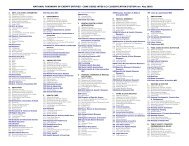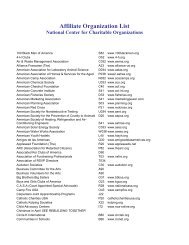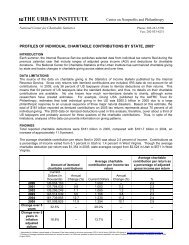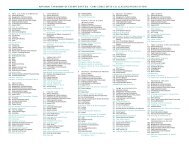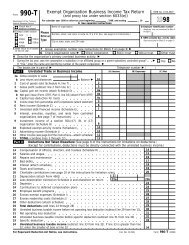Nonprofit Operating Reserves Initiative Workgroup - National Center ...
Nonprofit Operating Reserves Initiative Workgroup - National Center ...
Nonprofit Operating Reserves Initiative Workgroup - National Center ...
Create successful ePaper yourself
Turn your PDF publications into a flip-book with our unique Google optimized e-Paper software.
A WHITEPAPER<br />
BY: The <strong>Nonprofit</strong><br />
<strong>Operating</strong> <strong>Reserves</strong><br />
<strong>Initiative</strong> <strong>Workgroup</strong><br />
In spring 2008, a <strong>Nonprofit</strong><br />
<strong>Operating</strong> <strong>Reserves</strong> <strong>Initiative</strong><br />
<strong>Workgroup</strong> (see member list on<br />
page 10) comprising experienced<br />
individuals representing multiple<br />
facets of the nonprofit sector was<br />
convened with the objective of:<br />
1. Defining an “<strong>Operating</strong><br />
Reserve Ratio”<br />
2. Using the ratio to focus<br />
attention on the importance<br />
of nonprofit financial stability.<br />
The <strong>Nonprofit</strong> <strong>Operating</strong> <strong>Reserves</strong><br />
<strong>Initiative</strong> <strong>Workgroup</strong> reached<br />
consensus on definitions for<br />
operating reserves and the<br />
“<strong>Operating</strong> Reserve Ratio.” The<br />
workgroup also reached a<br />
conclusion on what constitutes<br />
adequate operating reserves.<br />
<strong>Workgroup</strong> member Richard<br />
Larkin had previously concluded<br />
and written that the answer is: it<br />
depends.” Drawing on Mr. Larkin’s<br />
insight and experience the<br />
workgroup concluded, there is no<br />
one size fits all ratio or<br />
benchmark. However, the<br />
<strong>Workgroup</strong> effort resulted in some<br />
insightful conclusions and<br />
recommendations that are shared<br />
in this White Paper.<br />
Final note: The <strong>Operating</strong> Reserve<br />
Ratio is one of a number of<br />
important and useful financial<br />
viability indicators that address<br />
various aspects of financial health.<br />
MAINTAINING NONPROFIT OPERATING RESERVES<br />
An Organizational Imperative for <strong>Nonprofit</strong> Financial Stability<br />
December 2008<br />
A top priority for nonprofit leaders needs to be maintaining operating reserves at<br />
levels adequate for achieving financial stability. While this may seem obvious,<br />
preliminary research indicates that many organizations neglect to put aside funds<br />
that will help them preserve their capacity to deliver on their missions in the event<br />
of unforeseen financial shortages.<br />
The fact is numerous nonprofits have negative reserves and are already at risk. The<br />
Work Group (see side bar) recognizes that the current economic crisis threatens<br />
the very existence of thousands of nonprofit organizations. At a time when<br />
nonprofit organizations may be focused on survival, the thought of building<br />
reserves may seem a distant priority. But for organizations currently just hanging<br />
on which expect to survive this crisis and those in relatively stable current financial<br />
condition which seek to fortify their position, the Work Group encourages<br />
including operating reserves in the planning process. Organizations which review<br />
their policies closely and devise plans for replenishing their operating reserves to<br />
an agreed upon adequate level will emerge from this current economic crisis in a<br />
stronger financial position, positioned to withstand the next challenge that arises.<br />
Briefly, operating reserves are the portion of “unrestricted net assets” (see Figure 1)<br />
that nonprofit boards maintain or designate for use in emergencies to sustain<br />
financial operations in the unanticipated event of significant unbudgeted increases<br />
in operating expenses and/or losses in operating revenues. “Unrestricted net<br />
assets” is a required line item in the balance sheets of financial statements<br />
prepared in accordance with generally accepted accounting principles (GAAP) and<br />
IRS Forms 990 of nonprofit organizations. [See “<strong>Operating</strong> Reserve Ratio” ‐ page 2]<br />
Figure 1 ‐‐ Suggested balance sheet net asset terms presented in an illustration that all nonprofit<br />
CEOs and boards need to understand.<br />
Equity in fixed<br />
Unrestricted Net Assets<br />
(Excluded from available<br />
unrestricted net assets*)<br />
Unrestricted Net Assets<br />
<strong>Operating</strong> <strong>Reserves</strong><br />
(Suggested Minimum Goal:<br />
25% of annual operating<br />
expense budget)<br />
Available*<br />
Unrestricted Net Assets<br />
Board Designated<br />
(Set aside for strategic purposes<br />
and/or quasi endowment)<br />
* Available unrestricted net assets could also exclude the equity in other non‐current, non‐liquid net assets<br />
such as long‐term receivables, inventory, prepaid expenses and deposits held by others.
MAINTAINING NONPROFIT OPERATING RESERVES: AN ORGANIZATIONAL IMPERATIVE FOR NONPROFIT STABILITY<br />
The amount of accumulated “unrestricted net<br />
assets” is increased or decreased as the result<br />
of annual operating surpluses or deficits.<br />
<strong>Nonprofit</strong>s pursue financial stability by<br />
budgeting for – and then achieving reasonable,<br />
modest surpluses year after year until they have<br />
met their operating reserves objectives.<br />
Two Inter‐Related Questions<br />
<strong>Nonprofit</strong>s can ask the following two questions<br />
to facilitate internal discussions about adequate<br />
operating reserves for financial stability.<br />
1. What does it mean to be financially stable?<br />
2. What are adequate operating reserves?<br />
According to Richard Larkin, CPA, <strong>National</strong><br />
Technical Director of Not‐for‐Profit Accounting<br />
and Auditing, BDO Seidman, LLP, the answer is,<br />
“It depends.” Mr. Larkin goes on to say, “It is<br />
best to start by saying that based on the<br />
literature available there is simply no single<br />
correct solution for all organizations. Despite<br />
the importance of the issue there exists no<br />
agreed upon industry benchmark. To<br />
complicate matters further, such benchmarks as<br />
are commonly used must be viewed in the<br />
context of the particular organization to which<br />
they are being applied.” 1<br />
OPERATING RESERVE RATIO<br />
The <strong>Nonprofit</strong> <strong>Operating</strong> <strong>Reserves</strong> <strong>Initiative</strong><br />
<strong>Workgroup</strong> recommends that nonprofit boards<br />
establish a minimum <strong>Operating</strong> Reserve ratio<br />
policy. An organization’s <strong>Operating</strong> Reserve<br />
Ratio can be calculated in terms of a percentage<br />
(operating reserves divided by the annual<br />
expense budget) or number of months<br />
(operating reserves divided by the average<br />
monthly expense budget). The minimum<br />
operating reserve ratio at the lowest point<br />
during the year suggested by the <strong>Workgroup</strong> is<br />
2<br />
25 percent or 3 months of the annual expense<br />
budget.<br />
The classification of unrestricted net assets in<br />
the balance sheet, as depicted in Figure 1, is<br />
critical to developing a clear and accurate<br />
snapshot of an organization’s financial position.<br />
“Available unrestricted net assets” are the<br />
portion of total unrestricted net assets that are<br />
available for use. A simple definition for<br />
“available unrestricted net assets” is<br />
unrestricted net assets less the equity in fixed<br />
assets – i.e., fixed assets net of related long‐<br />
term debt. A more conservative definition of<br />
“available unrestricted net assets” is footnoted<br />
in Figure 1. Each organization needs to<br />
determine if the simple definition can be used<br />
reliably for measuring <strong>Operating</strong> <strong>Reserves</strong> or if it<br />
needs to use a more conservative definition.<br />
“<strong>Operating</strong> <strong>Reserves</strong>” are that portion of<br />
“available unrestricted net assets” that an<br />
organization’s board maintains and/or has<br />
formally designated, or “reserved” for use in<br />
emergencies to sustain financial operations in<br />
the unanticipated event of significant<br />
unbudgeted increases in operating expenses<br />
and/or losses in operating revenues. The<br />
adequacy of operating reserves beyond the<br />
minimum is variable and depends on factors<br />
such as the reliability of operating revenues,<br />
impact of economic conditions among others.<br />
IRS FORM 990 AS HELPFUL TOOL<br />
The <strong>Workgroup</strong> concluded that the Form 990<br />
provides a good tool for illustrating the content<br />
of the <strong>Operating</strong> Reserve Ratio. Using the Form<br />
990, <strong>Operating</strong> <strong>Reserves</strong> consist of Unrestricted<br />
net assets less fixed assets net of debt. Fixed<br />
assets net of debt equals (Land, buildings, and<br />
equipment ‐‐ i.e., fixed assets) minus<br />
1 Determining Appropriate Levels of <strong>Reserves</strong>, Richard Larkin, CPA, <strong>National</strong> Technical Director of Not‐for‐Profit Accounting and Auditing, BDO Seidman, LLP, Bethesda Maryland.
MAINTAINING NONPROFIT OPERATING RESERVES: AN ORGANIZATIONAL IMPERATIVE FOR NONPROFIT STABILITY<br />
(Mortgages and other notes payable). Annual<br />
expenses consist of (Total functional expenses)<br />
less (Depreciation).<br />
NEARLY 50% HAVE LESS THAN THE MINIMUM<br />
Preliminary research indicates that a large<br />
portion of nonprofits may not have sufficient<br />
reserves to weather unexpected setbacks. For<br />
example, according to analysis of IRS Form 990<br />
data (2003) 2 , 1,516 or nearly fifty percent of<br />
3,154 nonprofits located in Washington, D.C.<br />
had year‐end operating reserve ratios below the<br />
suggested minimum of 25 percent or less than 3<br />
months of their annual expense budget. In<br />
fact, 996 nonprofits (32%) had reserve ratios of<br />
zero to 25 percent while 520 nonprofits (17%)<br />
actually had negative reserve ratios.<br />
IMPACT OF NEGATIVE OPERATING RESERVE<br />
RATIOS<br />
When the <strong>Operating</strong> Reserve Ratio is negative,<br />
be experiencing a serious, disruptive financial<br />
3<br />
crisis. For example, it may be having difficulty<br />
meeting payrolls, and/or may be seriously<br />
behind in paying its bills. It is likely operating<br />
hand‐to‐mouth ‐‐ disbursing funds as soon as<br />
they are deposited. The staff and members of<br />
the board can be devoting a disproportional<br />
amount of time on day‐to‐day financial<br />
management, resulting in a reduction in the<br />
delivery of program services. In some cases,<br />
staff may be asked to forego all or portions of<br />
their salaries. And, some staff members may<br />
leave for a more stable environment or may be<br />
subject to furloughs or layoffs. Internal controls<br />
may be ignored with less staff to do more work.<br />
Organizations with significant temporarily or<br />
permanently restricted net assets may be<br />
borrowing from those funds to cover deficits in<br />
unrestricted net assets available for operations.<br />
This is a very serious financial management<br />
problem because it violates the organization’s<br />
fiduciary responsibility to assure that restricted<br />
funds are used only for purposes designated by<br />
the donors.<br />
DESIGNATED FOR INTERNAL MANAGEMENT,<br />
NOT OUTSIDE WATCHDOG GROUPS<br />
Precisely because “it depends,” the <strong>Nonprofit</strong><br />
<strong>Operating</strong> <strong>Reserves</strong> <strong>Initiative</strong> <strong>Workgroup</strong><br />
adamantly maintains that any<br />
recommendations and/or guidelines outlined<br />
here are for the purpose of helping staff and<br />
boards better address the need for planning for,<br />
and measuring financial stability for their<br />
particular organization. Using “it depends” as<br />
the underlying theme for this Whitepaper is<br />
expected to put to rest any thought of using<br />
<strong>Operating</strong> Reserve Ratios to measure the<br />
“worthiness” of a nonprofit organization or to<br />
compare one organization with another.<br />
2 <strong>National</strong> <strong>Center</strong> of Charitable Statistics, <strong>Center</strong> on <strong>Nonprofit</strong>s and Philanthropy at the Urban Institute, IRS Form 990 data, circa 2003.
MAINTAINING NONPROFIT OPERATING RESERVES: AN ORGANIZATIONAL IMPERATIVE FOR NONPROFIT STABILITY<br />
APPLICABILITY<br />
The <strong>Nonprofit</strong> <strong>Operating</strong> <strong>Reserves</strong> <strong>Initiative</strong><br />
<strong>Workgroup</strong> believes this discussion is of value for<br />
all tax exempt organizations. Whether the annual<br />
budget is $100,000 or $10 million, committing to<br />
and holding an adequate reserve is an important,<br />
prudent business practice.<br />
ESTABLISH A POLICY<br />
Precisely because “it<br />
depends,” the <strong>Nonprofit</strong><br />
<strong>Operating</strong> <strong>Reserves</strong> <strong>Initiative</strong><br />
<strong>Workgroup</strong> recommends that<br />
every nonprofit organization<br />
have a written Reserve Policy<br />
that defines its own<br />
“adequate” operating reserve<br />
level, defines how its<br />
operating reserves are<br />
calculated and provides the<br />
rationale that led staff and<br />
Board to this conclusion. In<br />
general, for calculating the<br />
<strong>Operating</strong> Reserve Ratio, the<br />
<strong>Workgroup</strong> is strongly biased<br />
toward the simplest and most<br />
widely applicable formula.<br />
[See “<strong>Operating</strong> Reserve<br />
Ratio” on page 2.] The group also felt that<br />
operating reserves in an amount determined by<br />
an organization’s board to be “adequate”<br />
should be accumulated in advance of other<br />
board designated funds.<br />
FORMULATING THE POLICY<br />
Even the smallest nonprofit organizations could<br />
establish at least a simple reserves policy with<br />
the overarching purpose being to build and<br />
maintain a certain level of positive unrestricted<br />
net assets that can accommodate:<br />
A board may find it useful for internal<br />
accounting and reporting during the year<br />
to divide <strong>Operating</strong> <strong>Reserves</strong> into two<br />
unrestricted net asset accounts: “Board<br />
Designated <strong>Operating</strong> <strong>Reserves</strong>” and<br />
“<strong>Operating</strong> Funds.” The “Board<br />
Designated <strong>Operating</strong> <strong>Reserves</strong>” account<br />
would show the portion of <strong>Operating</strong><br />
<strong>Reserves</strong> that the board has designated for<br />
use in unusual or unforeseen financial<br />
emergencies. This net asset account<br />
could serve as an internal line of credit<br />
with board specified terms of use and<br />
replenishment. The “<strong>Operating</strong><br />
Funds” net asset account would show<br />
the remaining portion of “<strong>Operating</strong><br />
<strong>Reserves</strong>” and would fluctuate up or<br />
down according to day‐to‐day changes<br />
in normal cash flow activity.<br />
4<br />
a) day‐to‐day fluctuations in normal cash flow<br />
requirements, and<br />
b) unusual and/or unforeseen emergency cash<br />
requirements.<br />
Key steps for any organization in formulating<br />
the policy.<br />
1. Establish a minimum level for an<br />
adequate operating reserve ratio at the<br />
lowest point during the year. (The<br />
<strong>Nonprofit</strong> <strong>Operating</strong><br />
<strong>Reserves</strong> <strong>Initiative</strong><br />
<strong>Workgroup</strong> suggests<br />
25% of the annual<br />
operating expense<br />
budget as a starting<br />
point.)<br />
2. Define how the<br />
operating reserve<br />
ratio will be calculated<br />
[e.g., use formula<br />
shown in the<br />
“<strong>Operating</strong> Reserve<br />
Ratio section on page<br />
2 or another formula<br />
designed to meet<br />
specific operating<br />
reserves needs].<br />
3. Define how reserves will be invested as part<br />
of the overall Investment Policy Statement<br />
based on short, intermediate and long‐term<br />
needs.<br />
4. Define frequency of measuring and<br />
reporting on operating reserves. (As a<br />
minimum, the <strong>Nonprofit</strong> <strong>Operating</strong> <strong>Reserves</strong><br />
<strong>Initiative</strong> <strong>Workgroup</strong> recommends a<br />
monthly report to the CEO and a quarterly<br />
reporting system to the board’s finance<br />
committee.)
MAINTAINING NONPROFIT OPERATING RESERVES: AN ORGANIZATIONAL IMPERATIVE FOR NONPROFIT STABILITY<br />
5. Define methods by which the operating<br />
reserve will be replenished if it is used, or<br />
for any reason drops below the policy‐<br />
mandated minimum threshold at any point<br />
during the year. One example would be to<br />
establish a surplus budget in order to<br />
replace the lost revenue. For organizations<br />
with additional, non‐operating Board<br />
Designated funds, the recommended policy<br />
would be to re‐designate portions of those<br />
Board Designated special purpose funds as<br />
needed to replace lost value of operating<br />
reserves.<br />
“IT DEPENDS” FACTORS<br />
There are numerous “it depends” factors that<br />
make it impossible to construct a standard, one<br />
size fits all formula for what is the correct or<br />
adequate level of operating reserves for all<br />
organizations. In general, there is a continuum<br />
of variables that might influence what defines<br />
the appropriate operating reserve level for any<br />
given organization. The extent to which an<br />
organization finds itself more or less subject to<br />
the variables will influence how far above the<br />
suggested 25% baseline the adequate or<br />
appropriate reserve level is set. Some of these<br />
variables are outlined in detail in Appendix A –<br />
“It Depends” – Factors to Be Considered in<br />
Deciding What Amount of <strong>Reserves</strong> an<br />
Organization Will Plan to Maintain.<br />
BEYOND OPERATING RESERVES – FOR<br />
PROGRAM DEVELOPMENT<br />
The <strong>Nonprofit</strong> <strong>Operating</strong> <strong>Reserves</strong> <strong>Initiative</strong><br />
<strong>Workgroup</strong> suggests that adequate operating<br />
reserves are the basis for financial stability.<br />
However, for organizations that have a written<br />
policy and have successfully met the policy<br />
parameters for their <strong>Operating</strong> Reserve,<br />
establishing and budgeting surpluses needed<br />
5<br />
for additional Board Designated special purpose<br />
funds and/or Quasi‐Endowments are logical<br />
next steps to allow for planned, strategic<br />
program development that might include new<br />
programs, capital purchases, staff expansion,<br />
for example. By design this higher level of<br />
financial flexibility allows the organization to<br />
enhance quality, introduce new program<br />
elements and grow without compromising or<br />
jeopardizing core program delivery to existing<br />
constituents and stakeholders.<br />
“NONPROFIT” DOESN’T MEAN YOU CAN’T MAKE<br />
A “PROFIT” – SO STRIVE TO HAVE A SURPLUS<br />
The most financially stable nonprofits are being<br />
proactive in building reserves through annual<br />
surpluses, but as evidenced by the snapshot of<br />
DC nonprofits there are still many nonprofits<br />
living dangerously close to the bone. The staff<br />
and boards of nonprofits, as well as their<br />
funders, need to understand and agree not only<br />
that it is ok to save money and build a reserve,<br />
but that it is a critical necessity for long‐term<br />
sustainability. For nonprofits struggling but<br />
striving to reach a certain operating reserves<br />
threshold, the <strong>Nonprofit</strong> <strong>Operating</strong> <strong>Reserves</strong><br />
<strong>Initiative</strong> <strong>Workgroup</strong> advocates specifically<br />
budgeting for it as a disciplined approach to<br />
achieving the goal. In some cases this may also<br />
require a rigorous evaluation of the<br />
organization’s current operating model that has<br />
led to the chronic shortfalls.<br />
1. When an organization operates within a<br />
balanced budget that includes a modest<br />
surplus (e.g., 5%), operating revenues for<br />
the year will exceed operating expenses,<br />
with the result that the available<br />
unrestricted net assets would be increased<br />
at the end of each year. An organization<br />
with no reserves at all could thus plan to<br />
build its <strong>Operating</strong> Reserve Ratio to the
MAINTAINING NONPROFIT OPERATING RESERVES: AN ORGANIZATIONAL IMPERATIVE FOR NONPROFIT STABILITY<br />
suggested minimum 25% target over 5 to 6<br />
years of modest surpluses.<br />
2. The need for an operating reserve is clear:<br />
Without a reserve, the organization can be<br />
thrown into cash flow stress and become<br />
distracted from good long‐term decision‐<br />
making or forced to make expensive short‐<br />
term crisis‐based decisions, or worse; it may<br />
not have the resources to continue delivery<br />
of its programs.<br />
Over time, based on its existing available<br />
operating reserves and the percent of budget<br />
surplus added, the organization will have used<br />
its “profits” to prudently build the operating<br />
reserve to the level established in the<br />
organization’s policy as adequate or optimal.<br />
FINANCIAL STABILITY – IT’S EVERYONE’S<br />
RESPONSIBILITY<br />
After many hours of discussion and numerous<br />
iterations of this Whitepaper, the <strong>Nonprofit</strong><br />
<strong>Operating</strong> <strong>Reserves</strong> <strong>Initiative</strong> <strong>Workgroup</strong>’s<br />
conclusions are simple.<br />
1. <strong>Nonprofit</strong> organizations will be better<br />
managed and more financially stable if they<br />
have a policy defining an <strong>Operating</strong> Reserve<br />
Ratio level appropriate for the specific<br />
conditions in which that particular<br />
organization operates, with full support of<br />
the Board, CEO, CFO and other senior<br />
leadership.<br />
2. Because “it depends” on numerous<br />
variables, which are best known and<br />
applied to the decision by the organization<br />
itself, the best policy will be defined by the<br />
organization rather than by adhering to<br />
some arbitrary benchmark imposed by<br />
outsiders.<br />
6<br />
WHO ARE STAKEHOLDERS…WHAT CAN THEY DO?<br />
The stakeholders that can help nonprofits achieve<br />
financial stability include:<br />
CEOs, CFOs and boards of nonprofit<br />
organizations.<br />
Grant making community, such as program<br />
officers of foundations, regional<br />
associations of grant makers and<br />
government agencies.<br />
Associations of nonprofits and umbrella<br />
groups – geographic and subsector.<br />
Accountants such as individual CFOs and<br />
CPAs, CFO groups and CPA societies<br />
Management support organizations<br />
Academic centers with nonprofit programs<br />
Financial institutions serving the nonprofit<br />
sector<br />
All groups can encourage nonprofits to:<br />
Establish comprehensive written <strong>Reserves</strong><br />
Policies for maintaining adequate<br />
operating reserves for financial stability<br />
and generating special purpose funds for<br />
optimal mission accomplishment<br />
Employ budgeting and accounting<br />
procedures that implement their <strong>Reserves</strong><br />
Policy –effectively.<br />
<strong>Nonprofit</strong> Board members, CEOs and CFOs can ask<br />
for and receive at least quarterly reports.<br />
Resource providers can encourage and permit<br />
budgeting surpluses and building reserves.
MAINTAINING NONPROFIT OPERATING RESERVES: AN ORGANIZATIONAL IMPERATIVE FOR NONPROFIT STABILITY<br />
3. By taking this conscious and proactive<br />
approach to setting its own financial goals,<br />
the staff and board take responsibility for<br />
the financial stability of the organization.<br />
4. It is important that institutional funders,<br />
individual donors, and other community<br />
leaders understand the need for small and<br />
midsized nonprofit organizations to build<br />
and sensibly use their unrestricted net<br />
assets to create an operating reserve that<br />
achieves financial sustainability.<br />
CALL TO ACTION<br />
The preliminary facts tell us that nearly 50% of<br />
nonprofit organizations in the DC metropolitan<br />
area have operating reserves of less than 25%.<br />
As a result of these preliminary findings the<br />
Urban Institute is planning to do a more in‐<br />
depth study of the data. This research project<br />
will help better define and quantify the state of<br />
financial stability among area nonprofits. And,<br />
while that information will prove extremely<br />
valuable, you as a board member, a CFO, a<br />
donor, a funder or any other nonprofit<br />
stakeholder need not wait to take action. If you<br />
know of an organization that appears to be<br />
struggling to achieve this objective, share this<br />
information with key leadership. If your<br />
organization doesn’t have a policy, establish<br />
one. If your organization has a policy but has<br />
not reviewed it in the last three years, pull it out<br />
and evaluate it.<br />
There is no one size fits all solution, but there is<br />
a solution that is right for every organization if<br />
the key stakeholders take the time and effort to<br />
understand and define what is best for your<br />
situation. The region depends so much on<br />
nonprofits to deliver myriad services to valued<br />
citizens of our community. And, achieving<br />
financial stability is a critical component of your<br />
mission sustainability. Take the necessary steps<br />
to be financially stable so that our community<br />
can continue to benefit from your mission.<br />
7<br />
HELPFUL RESOURCES RELATED TO NONPROFIT<br />
OPERATING RESERVES INITIATIVE<br />
Working Papers and Helpful Resources of the<br />
<strong>Nonprofit</strong> <strong>Operating</strong> <strong>Reserves</strong> <strong>Initiative</strong> <strong>Workgroup</strong><br />
can be found at the website (see p.10 for link)<br />
provided by <strong>Center</strong> on <strong>Nonprofit</strong>s and Philanthropy at<br />
The Urban Institute, which serves as secretariat to the<br />
<strong>Workgroup</strong>.<br />
Supplements to <strong>Nonprofit</strong> <strong>Operating</strong> <strong>Reserves</strong><br />
White Paper.<br />
• Impact of inadequate <strong>Operating</strong> <strong>Reserves</strong>.<br />
• Defining the <strong>Operating</strong> <strong>Reserves</strong> Ratio.<br />
• “It Depends” – Factors to Be Considered in<br />
Deciding What Amount of <strong>Reserves</strong> an<br />
Organization Will Plan to Maintain.<br />
Initial <strong>Nonprofit</strong> <strong>Operating</strong> Reserve Ratio Working<br />
Documents<br />
• <strong>Nonprofit</strong> <strong>Operating</strong> Reserve Ratio (primary<br />
working paper for White Paper – August draft)<br />
• Summary <strong>Nonprofit</strong> <strong>Operating</strong> Reserve Ratio<br />
Related papers by Richard F. Larkin, CPA, BDO<br />
Seidman, LLP<br />
• <strong>Nonprofit</strong>s and Squirrels – or, How big a reserve<br />
do you need?<br />
• Determining Appropriate levels of <strong>Reserves</strong>.<br />
Illustrative reserves policies<br />
• United Way of America <strong>Reserves</strong> Policy<br />
• Illustrative Guidelines for Developing a<br />
<strong>Reserves</strong> policy<br />
<strong>Reserves</strong> policy toolkit – 1.0 (Scheduled to be<br />
completed Spring 2008.)<br />
All documents are downloadable in PDF format and also<br />
available in word on request to Bill Levis<br />
(qrlevis@aol.com). The views recommendations and<br />
suggestions expressed in the White Paper and other<br />
documents are those of the <strong>Nonprofit</strong> <strong>Operating</strong><br />
<strong>Reserves</strong> <strong>Initiative</strong> <strong>Workgroup</strong>. Some <strong>Workgroup</strong><br />
members may disagree on some points. <strong>Workgroup</strong><br />
positions on the issues have been established on a<br />
consensus basis. <strong>Workgroup</strong> members represent<br />
themselves and not their affiliations. These documents<br />
are not research‐based papers of the <strong>Center</strong> on<br />
<strong>Nonprofit</strong>s and Philanthropy at The Urban Institute.
MAINTAINING NONPROFIT OPERATING RESERVES: AN ORGANIZATIONAL IMPERATIVE FOR NONPROFIT STABILITY<br />
Factors whose presence would indicate that the<br />
organization probably should try to maintain a higher*<br />
level of reserves<br />
<strong>Operating</strong> Funds [for financial sustainability]<br />
The main sources of expendable revenue may be subject to<br />
large unexpected negative fluctuations. 1<br />
The nature of our activities is such that there is a high risk of<br />
there being significant unpredictable demands on our<br />
resources. 2<br />
Our regular day‐to‐day fluctuations in income and expenses<br />
are significant. 3<br />
Our governing board takes a longer‐term view of provision<br />
of services and its attitude is to be very sure there are<br />
always resources available.<br />
Our governing board’s approach to planning and budgeting<br />
is a conservative and prudent one. While the organization<br />
may never have faced an event requiring the extended use<br />
of our reserves, the board considers this a fundamentally<br />
sound financial management practice.<br />
Our planning and budgeting processes have historically<br />
proved to be less accurate in forecasting financial results. 4<br />
Adequate backup sources of resources are not in sight.<br />
The board is not trying to expand the organization.<br />
Board Designated Funds [for optimal mission<br />
accomplishment]<br />
The nature of our activities is such that there is a high<br />
likelihood that unexpected opportunities will come our<br />
way, requiring additional (available) resources to take<br />
advantage of these opportunities. 7<br />
There is a sense that a change in organizational direction<br />
may be considered desirable in the not‐so‐distant future. 8<br />
Appendix A ‐ “IT DEPENDS”<br />
Factors to Be Considered in Deciding What Amount of <strong>Reserves</strong> an Organization Will Plan to Maintain<br />
By Richard F. Larkin, C.P.A., BDO Seidman, LLP (Member <strong>Nonprofit</strong> <strong>Operating</strong> <strong>Reserves</strong> <strong>Initiative</strong> <strong>Workgroup</strong>)<br />
• Every organization should plan for its reserves. Consider how the factors below might affect you. Your board,<br />
with advice of management, should adopt a formal policy for the reserve level it wishes to maintain, and review<br />
that policy regularly. Of course you cannot just make reserves appear on command; it may take an extended<br />
period to accumulate the desired level.<br />
• Following is a list of factors to be considered by nonprofit organizations in making that decision. In many cases,<br />
no one of these factors will be determinative by itself; all applicable factors should be considered together.<br />
8<br />
Factors whose presence would indicate that the<br />
organization can likely get along with a lower* level of<br />
reserves<br />
Our main sources of revenue are generally not subject<br />
to large unexpected negative fluctuations.<br />
It is less likely that significant unexpected demands on<br />
our resources will occur.<br />
Our regular day‐to‐day fluctuations are relatively minor.<br />
The governing board believes it is of overriding<br />
importance that every possible resource is used in the<br />
provision of current program services.<br />
The governing board is generally willing to live ‘day‐to‐<br />
day’ and trust that resources will be available when<br />
needed. The board believes it is of overriding<br />
importance that every possible resource is used in the<br />
provision of current program services.<br />
Our planning and budgeting processes have historically<br />
proved to be fairly accurate in forecasting financial<br />
results.<br />
We are confident that adequate backup sources of<br />
resources are likely to be available in a pinch. 5<br />
The board is trying to aggressively expand the<br />
organization and available resources are to be used for<br />
expansion, including portions of its operating reserves 6<br />
The nature of our activities is such it is not very likely<br />
that such opportunities will come our way requiring<br />
additional (available) resources.<br />
There is no change in organizational direction<br />
anticipated any time soon.<br />
*Note: No attempt is made here to quantify “higher” or “lower” reserves. That has to be done by each organization, taking into consideration<br />
the wide range of circumstances that impact the organization’s budget and operations. A reserve level that might be considered high for one<br />
organization may be completely inadequate for another. IT DEPENDS.<br />
FOOTNOTE references in this table are detailed on page 9.
MAINTAINING NONPROFIT OPERATING RESERVES: AN ORGANIZATIONAL IMPERATIVE FOR NONPROFIT STABILITY<br />
Appendix A ‐ “IT DEPENDS” Continued<br />
FOOTNOTES corresponding with references made in Table A on page 8.<br />
1. Examples might include: Unexpected, unplanned events that negatively affect charitable giving and fee income; natural<br />
disasters such as earthquakes, floods and hurricanes; a blizzard the day of your big annual gala fundraiser; general poor<br />
economic conditions or rising costs; organizational problems such as volunteer and staff misdeeds or lawsuits generating<br />
unfavorable publicity which turns away customers and donors; overly‐optimistic budgeting of anticipated revenue (very<br />
common); dependency on one donor for 10% or more of the annual budget; short‐term or non‐renewable agreements such<br />
as some cause‐related marketing contracts and corporate sponsorships; many other reasons.<br />
2. Examples might again include: Unexpected, unplanned events that negatively affect giving and/or increase demand for our<br />
services (economic downturn, unusual weather patterns) Organizations most likely affected are disaster or situational<br />
response organizations – for example the Red Cross; United Way organizations, health and human services organizations<br />
such as food kitchens, homeless shelters.<br />
3. Payrolls have to be paid every payday. The electric company is likely to want cash, not a promise, to keep the power flowing.<br />
But income often comes in spurts, especially contributions. Also there may be seasonal factors. For example, many<br />
contributions probably arrive in December as donors do personal tax planning. Colleges collect tuition at the beginning of<br />
each semester, and then have to live off it until next semester. Orchestras sell season tickets in the spring to pay for<br />
concerts to be put on over the following winter. On the other side, utility costs are probably higher in the winter and<br />
summer (heating and air conditioning), but lower in between. Expenses of our annual conference will be bunched around<br />
the time of the conference.<br />
4. For example, you have had numerous instances of situations such as cost overruns, or, ‘The project that everyone thought<br />
would succeed, didn’t.’ ‘The foundation grant that you thought was in the bag wasn’t.’ ‘The big fundraising event failed to<br />
meet expectations.’<br />
5. This is your Plan B. For nonprofits this can be some combination of: cash on hand, investments and surplus assets that can be<br />
sold, a bank line‐of‐credit, a foundation or other institutional funder that you know would help if asked, some individual<br />
donors who could be counted on if the going gets really rough, a plan to cut expenses to a bare bones level for a while. If an<br />
organization uses this to justify not establishing a reserve, they should define in writing this “Plan B” which names sources<br />
(to include: held assets, organizations and individuals) from which funds would come.<br />
6. For example, the organization could be new and trying to reach a sustainable size or have a special opportunity that warrants<br />
risking a portion of its operating reserves.<br />
7. For example, recently an extremely rare major dinosaur fossil became available at public auction. Museums knew that it<br />
would sell for a high price, and it did. If your museum wanted this for its collection, it had to have resources available to<br />
cover the cost.<br />
8. A long‐standing program just isn’t what’s best any more. Community needs have shifted. Resources will be required to<br />
phase out the old and bring in the new. The parallel here is to seed capital in a business.<br />
9
MAINTAINING NONPROFIT OPERATING RESERVES: AN ORGANIZATIONAL IMPERATIVE FOR NONPROFIT STABILITY<br />
Appendix B – NONPROFIT OPERATING RESERVES INITIATIVE WORKGROUP MEMBERS<br />
<strong>Nonprofit</strong> <strong>Operating</strong> <strong>Reserves</strong> <strong>Initiative</strong> <strong>Workgroup</strong> members represent themselves and not their affiliations.<br />
Positions on recommendations and issues are established on a consensus basis; some members may disagree on<br />
some points. <strong>Workgroup</strong> members are encouraged to invite others to join. The <strong>Center</strong> on <strong>Nonprofit</strong>s and<br />
Philanthropy at The Urban Institute serves as secretariat for the <strong>Workgroup</strong>.<br />
<strong>Workgroup</strong> coordinators, identified with an (*) in list below, can be reached at James_Schmutz@ml.com,<br />
qrlevis@aol.com and bessfoley@gmail.com. <strong>Workgroup</strong> draft materials and papers can be found at:<br />
http://www.nccs2.org/wiki/index.php?title=<strong>Nonprofit</strong>_<strong>Reserves</strong>_<strong>Workgroup</strong>. 1/13/09<br />
Rob Batarla, American Physical Therapy Association<br />
Wendy Batkin, <strong>Nonprofit</strong> Consultant<br />
Elizabeth Boris, <strong>Center</strong> Director, CNP, The Urban Institute<br />
Mary Buszuwski, ANA<br />
Gale Case, Rothstein Kass<br />
Glenda Cognevich, DC Central Kitchen<br />
Gail Crider, <strong>National</strong> Arts Strategies<br />
Linda Crompton, BoardSource<br />
Cami Cumblidge, Nebraska Council of School Administrators<br />
Mary Ann de Barbieri, de Barbieri & Associates<br />
Keith Danos, Jewish Federation for Group Homes<br />
Tim Delaney, <strong>National</strong> Council of <strong>Nonprofit</strong>s<br />
Rick Dorman, GWSCPA<br />
Phyllis Edans, American College of Emergency Physicians<br />
Ken Euwema, United Way of America<br />
(*) Bess Foley, <strong>Nonprofit</strong> Finance & Accounting Consultant<br />
[<strong>Workgroup</strong> Coordinator]<br />
Carlos Gomez‐Montes, United Way of America<br />
Flo Greene, California Assn of <strong>Nonprofit</strong>s<br />
William Hamm, Interim President, Wartburg College<br />
Bob Hawkins, concerned citizen<br />
Marge Heitbrink, Wise Giving Alliance, CBBB<br />
George Hergenhahn, Special Olympics Maryland<br />
Deborah Hickox, Goodwill of Greater Washington<br />
Maria‐Nelly Johnson, Special Olympics District of Columbia<br />
Lisa Junker, ASAE<br />
Fred Lane, <strong>Center</strong> for <strong>Nonprofit</strong> Strategy and Management,<br />
Baruch College/CUNY<br />
Dick Larkin, BDO Seidman<br />
(*) Bill Levis, Senior Associate, NCCS, The Urban Institute<br />
[<strong>Workgroup</strong> Coordinator]<br />
10<br />
Elaine Lynch, American Anthropological Assn<br />
Dawn Mancuso, Association of Air Medical Services<br />
Christine Manor, QuickBooks for NPOs<br />
Jan Masaoka, Blue Avocado<br />
Corey McIntyre, <strong>National</strong> Association of Independent Schools<br />
Chuck McLean, VP Research and Data Quality, Guidestar<br />
Rick Moyers, Meyer Foundation<br />
Patty O’Malley, Rubino & McGeehin<br />
Tom Pollak, Program Director, NCCS, The Urban Institute<br />
Dennis Ramprashad, MillerMusmar, [Chair, GWSCPA QR Task<br />
Force]<br />
Celeste Regan, <strong>National</strong> Park Foundation<br />
Sally Rudney, The Montgomery County Community Foundation<br />
Daniel Saat, Tides Foundation<br />
Susan Sanow, <strong>Center</strong> for <strong>Nonprofit</strong> Advancement<br />
(*) Jim Schmutz, Merrill Lynch [<strong>Workgroup</strong> Coordinator]<br />
Jeff Schragg, Argy, Wiltse & Robinson<br />
Cathy Stegmaier, Alliance of Cambridge Advisors<br />
Suzanne Stone, Society for Women’s Health Research<br />
Janette Stout, Southeastern University Research Assn<br />
Alan Strand, California Association of <strong>Nonprofit</strong>s<br />
Russy Sumariwalla, Global Philanthropy & <strong>Nonprofit</strong>s<br />
Russell Willis Taylor, <strong>National</strong> Arts Strategies<br />
A. Irene Tongelidis, Accounting and Consulting Services<br />
Tim Walters, Association for Small Foundations<br />
Bennett Weiner, BBB Wise Giving Alliance<br />
Yonas Weldemariam, Society for Women’s Health Research<br />
Brian Williams, Step Afrika!<br />
Jack Ziegler, Movement Advancement Project/LGBT<br />
Joe Zillo, Defenders of Wildlife<br />
Steve Zimmerman, Spectrum <strong>Nonprofit</strong> Services LLC



